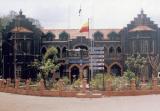In the late 40s, we moved to Bangalore having bought a house owned by a departing Britisher, a Charles Marsh and the house was called ‘The Marshes’. It literally lay in the marshes, all one acre of it, wedged between the two lakes, one of which when it overflowed ran over the bund that was our access road. There wasn’t much habitation as it lay in close proximity to two graveyards, one a huge Hindu one and the other a smaller Muslim one. Though the mud road that lay between the two graveyards connected our road to the Lalbagh, it was never used except to cart dead bodies.
The City Corporation at some point in the early 50s decided to put life into that road and thought up an ingenious idea. Why not divide the road and mark out uniform sites on either side allowing for bigger sites in the corners? Well, of course, it had to be called ‘Double Road’, the first in town to carry that sobriquet. The grand day arrived for testing the waters. A man went round with a drum announcing the sale of sites for homes by auction on the following Sunday. The mud road, now divided into two mud roads, were cleared of the debris collected over years and in the middle, a platform was erected for the great occasion. The District Magistrate arrived with his minions, who set up a podium and chairs, as the drummers drummed louder and louder…nothing happened except for some grave diggers stirring out to see whether fresh bodies had arrived.
Realising that this is a no-go situation, the District Magistrate enquired whether there was any noted (monied) person living close by. His heart swelled with hope when my father was mentioned as the only money bag around. He knew him from excise auctions. Thus my father was summoned and addressed with great grace. My father’s generation treated these exalted gentlemen of the Government as next only to God. ‘Appane aaga beku’ (orders your grace), ‘Nodi, saukarre namma mana ulisa beku’ (you must save my honour) ‘ayyo yenubekadaru heli’ (anything you say) “ondu site adaru marde nanu hogoke agalla. Nimma hesaralli ondu 5 site nanu register madtini” (I can’t go without selling a single site. I will register five in your name). Thus my father had five sites, two on either side, and one larger one in the corner. Returning home, he called up his friends – a lowly bank manager, a retired Thasildar, a poor relative. On arrival, they were told they owned sites. As they demurred, he cut them short ‘Did I ask you for money?’ Watching the sites going at such a pace, mother could not but put in her bit. “I don’t have anything in my name”. So one went to her and the other to the quietest brother in the family. The purchase value of the sites? Rs 4,500 for the regular and Rs 6,500 for the corner.
Years passed. I went abroad and when I was there, my father had a stroke. Though he recovered, he was never the same again becoming increasingly immobile. A few years later he passed away. One morning, a man sat in our yard and wished to meet my mother. He spent a long time with her and did not have time enough to unburden his gratitude to us, particularly to father. When he retired from the bank, he had nothing much in terms of the severance pay but he had the burden of getting his daughter married. He had borrowed on pledging the site father had gifted. And then had settled into retirement that is, until a few months ago, he woke up to the fact that the piece of land he owned now was the prize of princes, for the Double Road had become the main arterial road to the burgeoning Bangalore South. Overnight, he was rich enough not only to buy a place but also build a comfortable two-storied bungalow that gave him permanent income from the renting of one floor and living in another… a place of his own. He had tears in his eyes as he recounted the tale. That patch of land, which made him a fortune, was now on Kengal Hanumanthaiah Road connecting downtown with a vast extension called Jayanagar and other extensions beyond.
source: http://www.deccanherald.com / Deccan Herald / Home> Supplements> MetroLife / by M Bhaktavasala / DHNS – November 04th, 2014






